Scheduling Update Jobs
From the Update Manager Homepage, select the Update Scheduler tile.
The first time you access the Manage jobs page no jobs will be defined. Use the Define Job button to define jobs. See Defining Jobs.
This example illustrates the fields and controls on the Manage Jobs when no jobs have been defined.

After job have been defined and scheduled or run, the Manage Jobs page will display the Job Status.
This example illustrates the fields and controls on the Manage Jobs page. You can find definitions for the fields and controls later on this page.
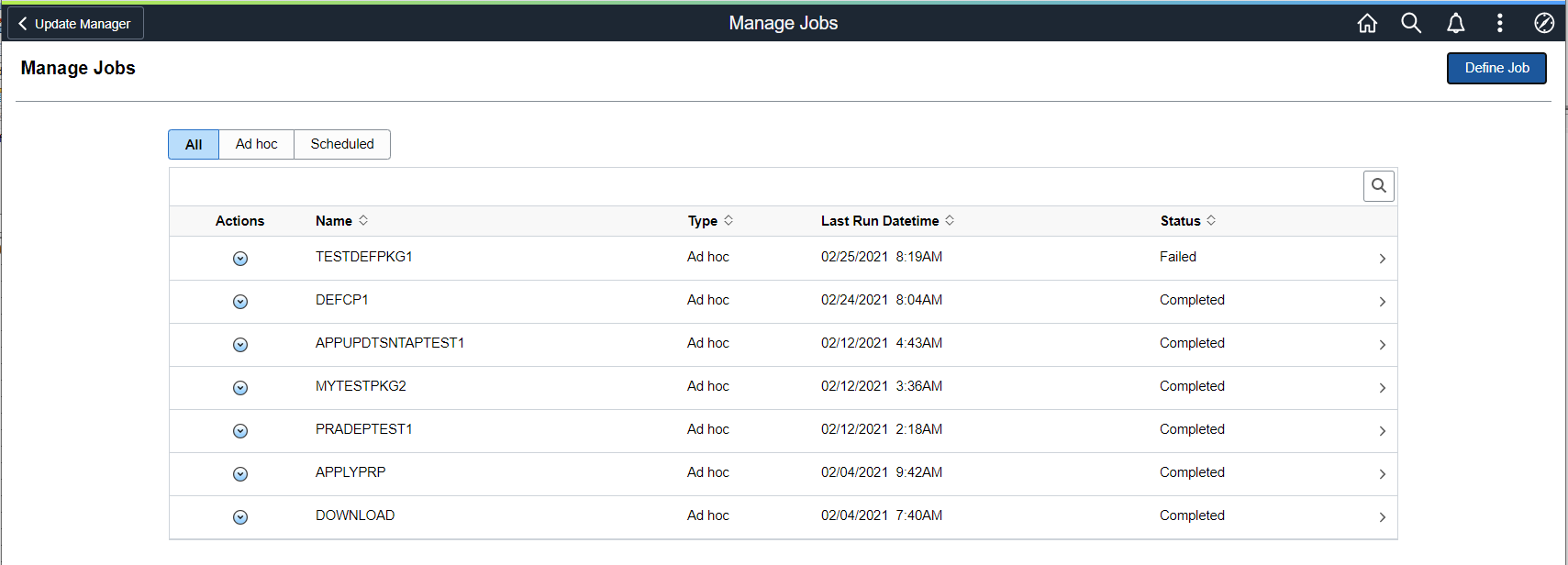
Field or Control |
Description |
|---|---|
Actions |
Actions include:
|
> |
Use the > icon to view the Job Monitor. The Job Monitor can also be accessed by clicking the row. For details, refer Viewing Job Monitor |
Select the Define Job button on the Manage Jobs page to define a new PAU job.
This example illustrates the fields and controls on the Define Job page. You can find definitions for the fields and controls later on this page.

Field or Control |
Description |
|---|---|
Name |
Enter a job name. |
Type |
Select the job type:
|
|
Download Application Update Image |
Select Yes to download Application Update Image DPKs. Starting with PeopleTools 8.60, customers can download an Application Update Image DPKs from the Update Manager (Define Job) page. Customer will be able to download Application Update Image DPK based on the application pillar environment in use. For example, you can schedule or download HCM Application Update Image DPKs from an HCM PUM source. Note: You can continue to download Application Update Image DPKs manually from My Oracle Support or Oracle Software Delivery Cloud as in previous releases. For more details, refer Downloading Application Update Image DPKs |
Download PRPs from MOS |
Select Yes to download PRPs from MOS. Note: The Download Manager validates each PRP before downloading and ignore PRPs that are incompatible with the currently installed PeopleSoft Image. |
Apply PRPs to PUM Source |
Select Yes to Apply PRPs to PUM Source. |
Define Change Package |
Select Yes to Define Change package using Previously Defined or Standard System search criteria. |
Create Package |
Select Yes to create the defined change package. |
Apply CP (IP: Source Only Steps) |
Select Yes to apply the source only steps. The Source Steps Only option runs the initial pass on the PUM source and creates all files that are contained in the change package. Once the initial pass has completed, a modified change package is created that contains all the files. The modified update change package can then applied to the target database using the Target Only option. |
On the Define Job page, select Type: Scheduled.
This example illustrates the fields and controls on the Defining Scheduled Job. You can find definitions for the fields and controls later on this page.
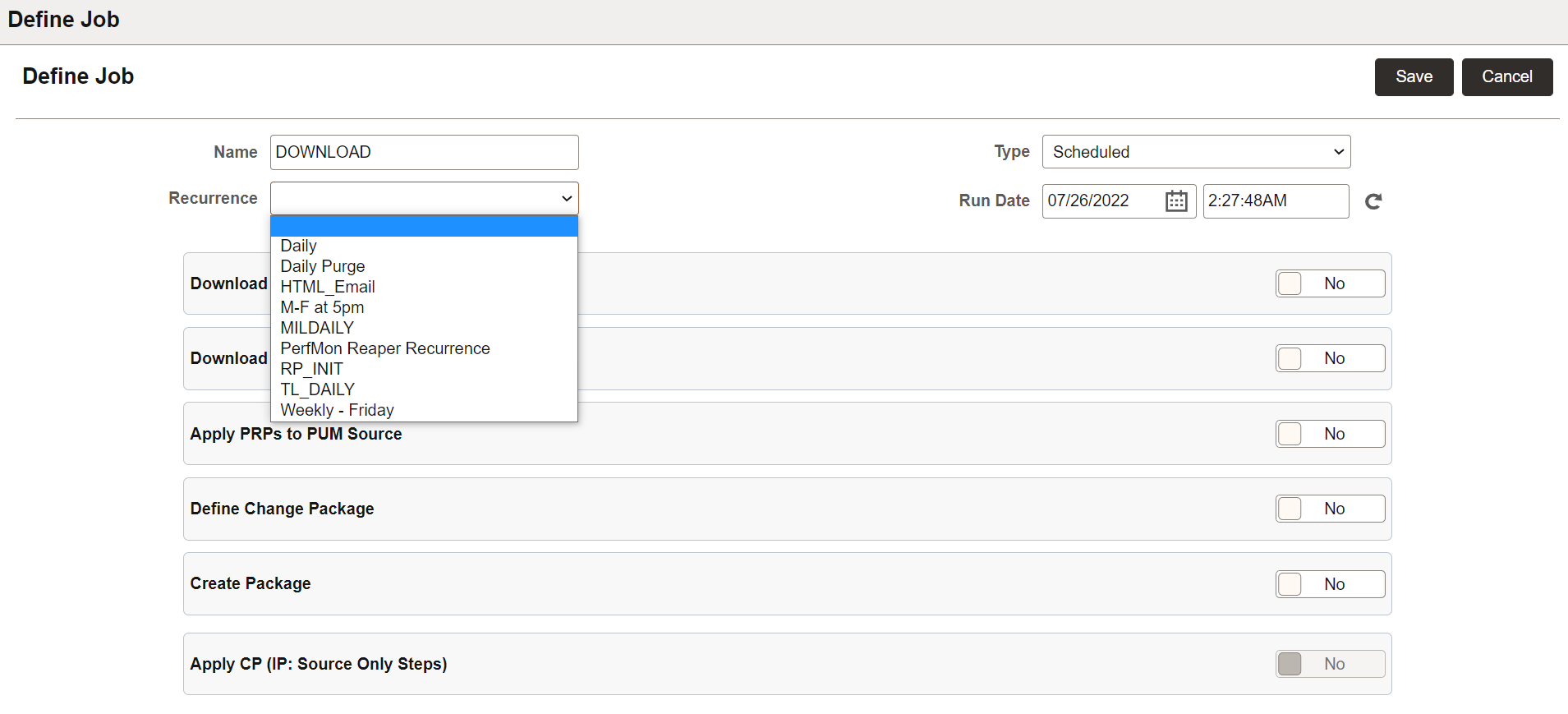
Field or Control |
Description |
|---|---|
Type |
Scheduled |
Run Date |
Select the date and time to run the job. |
Recurrence |
Use this option to set up the job on a recurring schedule. Select the recurrence name from the drop down list. To add a new recurrence definition see Defining Recurrence Definitions |
On the Define Job page, select Download Application Update Image.
You can run a job for this Download Application Update Image task on an ad hoc or scheduled basis.
Note: The Download Application Update Image task cannot be combined with other tasks, such as, Create Package. It requires a separate job to run.
This example illustrates the fields and controls to download Application Update Image DPK.
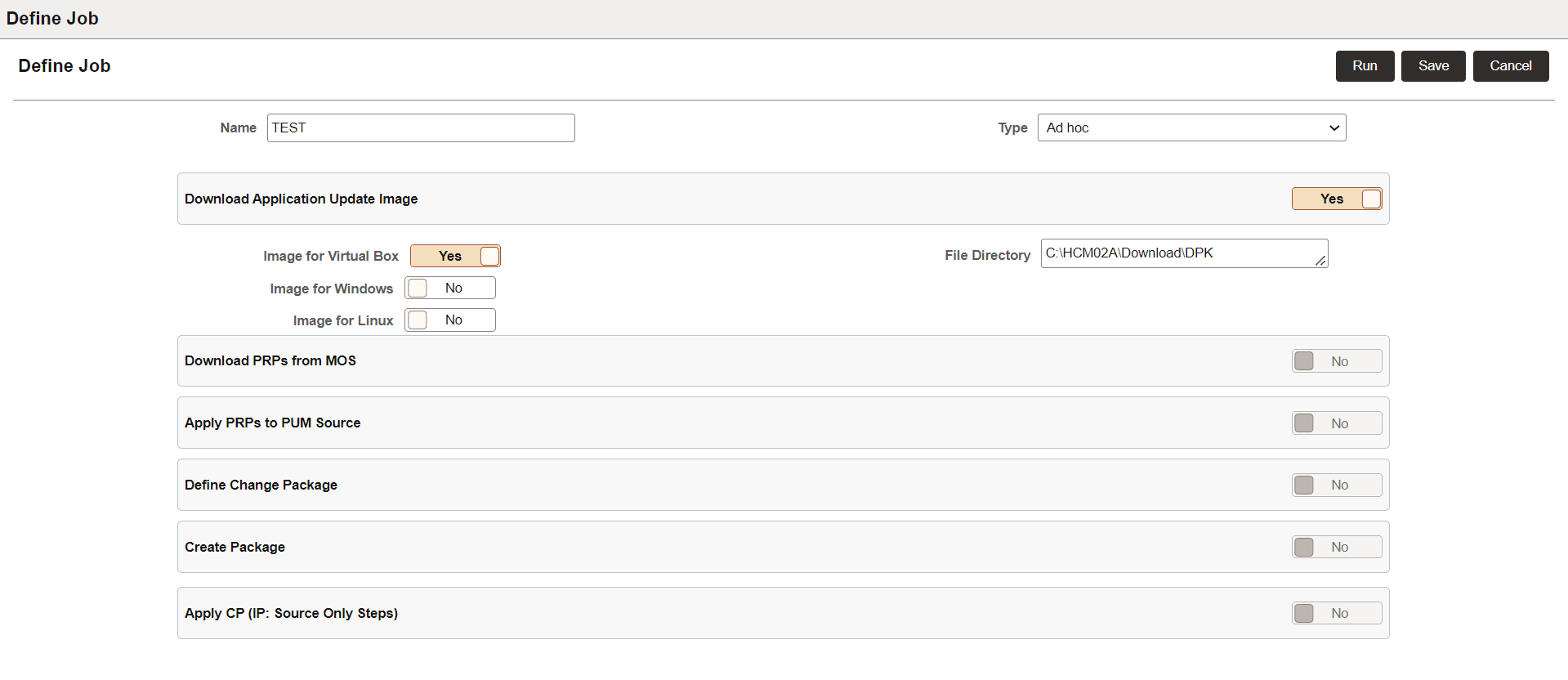
|
Field |
Description |
|---|---|
|
Image for Virtual box, Image for Windows, Image for Linux |
The three types of Application DPKs or Update Image patch sets that is available for download. |
|
File Directory |
Specify the directory to download the DPK. It can be any relevant path in Process Scheduler to which PAU has access. It can be a local path or network path (Windows or Linux machine). In Windows, it is not recommended to use mapped shared folder as download location for the PAU DPK. If shared folder path is provided, it is recommended to provide the complete UNC path. Example of UNC path is, \\server-name\shared-resource-pathname. This directory is validated to check if sufficient space is available on file system for the current download job. |
Note that when any PAU job runs, the other PAU jobs, such as download or apply PRP and create or define Change Package, are in queue.
When you select to Define a Change Package, you will need to enter additional information.
After you Save the job, you can run the job directly from this page using the Run button.
This example illustrates the fields and controls on the Define Job page for defining a change package PAU job.

Field or Control |
Description |
|---|---|
Package Name |
Enter a name for the change package. |
Package Suffix |
Select a suffix, choices are:
|
Package Description |
Optionally add a description. |
Target DB |
Select the target database from the drop down list. |
Select the Search Scope |
Search Scope choices are:
|
Search Name |
Select the search name from the drop down list. |
You can define a change package and create the change package in different PAU jobs. These two jobs are completely independent.
Prior to PeopleTools 8.60, you had to define and create change packages in a single job.
Use the Create Package task in PAU job to create change packages that are either defined in the Define Change Package wizard in the Update Manager tile or in the PAU job.
This example illustrates the fields and controls to search for the change packages defined in Update Manager tile or in the PAU job.

Select the Apply CP (Source Only Steps) option, to apply the change package created. This option applies only the source only steps.
Select the History action from the Manage Jobs page to view the job history.
This example illustrates the fields and controls on the Job History page. You can find definitions for the fields and controls later on this page.

Field or Control |
Description |
|---|---|
Status |
There are two status fields. Job level status- Displays the current status of the job. The status can be COMPLETED only when the all the activities within the job has a COMPLETED status. Activity level status- Displays the status of an activity in the job. |
|
|
Select to view the job template detail. This template appears only for Apply Change Package and Apply PRP tasks. |
|
Select to view the job log for the activity. |
Download Logs |
Select to download the logs. |
Use the Job Monitor to monitor the status of job activities, logs, and download logs.
To view the Job Monitor, from the on the Manage Jobs page either click the row for the job or use the > icon.
This example illustrates the fields and controls on the Job Monitor page. You can find definitions for the fields and controls later on this page.

Field or Control |
Description |
|---|---|
|
Select to view the job template. |
|
Select to view the job log. |
Download Logs |
Select to download a zip file which includes all the logs for the job. |
This example illustrates the fields and controls on the Job Detail Template. You can find definitions for the fields and controls later on this page.
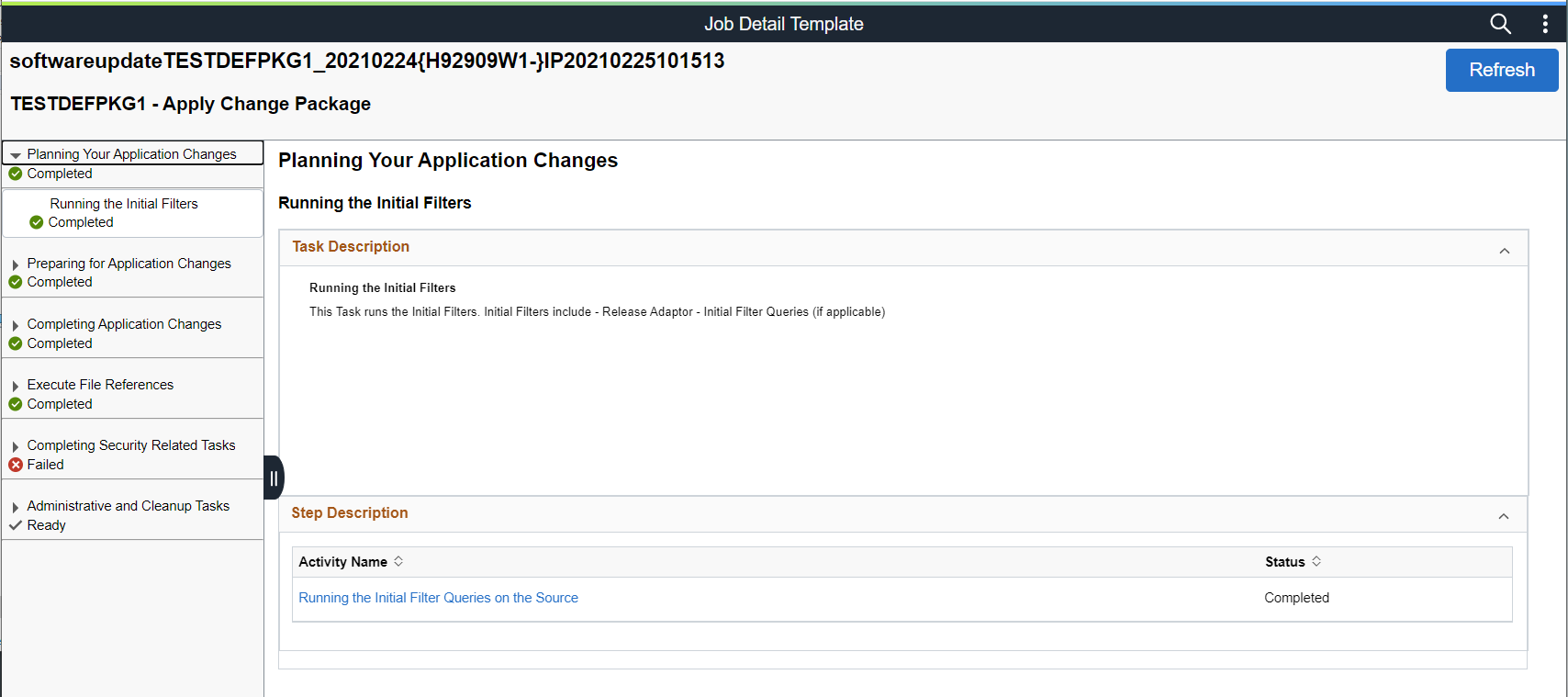
The list of chapters, tasks and steps are listed on the left hand side of the page. Select the chapter, task or step to view.
Select the Resume button on the Job Monitor page to resume a job.
You can resume a job:
If the job encounters a manual stop.
If a PRP fails with 'Applied with Warnings' status.
If the job encounters a manual stop, the user must mark the step as complete and continue to run the job.
If the job fails for on a step in the template, the user can select to either Mark the step as manually complete and continue to run the job or Mark the step to restart and continue to run the job.
This example illustrates the fields and controls on the Resume Job. You can find definitions for the fields and controls later on this page.
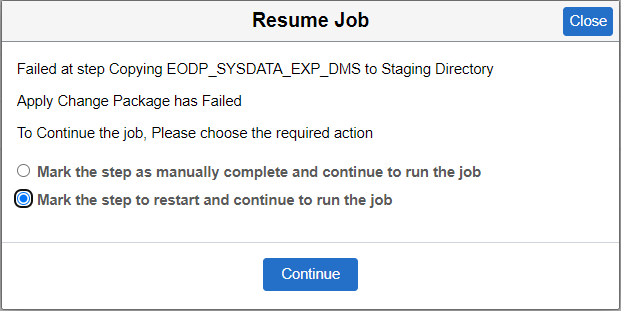
Sometimes a PRP fails when a job stops with the 'Applied with warnings' status. Review the warnings to fix the issue and resume to apply the PRP from the Job Monitor page.


